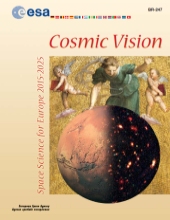Four candidates selected for the next medium-class mission in ESA's Cosmic Vision
25 February 2011
Looking ahead to the next decade of scientific exploration, ESA has today (25 February) selected four candidates for a medium-class mission that will launch in the period 2020-22. The candidates cover very different areas of scientific research, ranging from investigations of black holes and general relativity to near-Earth asteroid sample return and studies of planets orbiting distant stars."There was huge interest in this flight opportunity from right across the scientific community," said Fabio Favata, Head of ESA's Science Planning and Community Coordination Office. "The competition for this launch opportunity is the strongest to date for the ESA Science Programme."
 |
As a result of this review process, recommendations based on the scientific excellence of the missions were forwarded by the Space Science Advisory Committee to David Southwood, ESA's Director of Science and Robotic Exploration.
The Director has now selected four missions to undergo an initial Assessment Phase. Once this is completed, a further down-selection will be performed, leading to a decision on which mission will be finally implemented.
"This selection of medium-class mission candidates is a major milestone in the definition of ESA's future science programme," said Professor Southwood.
"All of the missions selected for the Assessment Phase promise exciting scientific breakthroughs and choosing the mission that will be implemented will be a difficult process."
The four proposals chosen to proceed for assessment are EChO, LOFT, MarcoPolo-R and STE-QUEST.
- The Exoplanet Characterisation Observatory (EChO) would be the first dedicated mission to investigate exoplanetary atmospheres, addressing the suitability of those planets for life and placing our Solar System in context.
Orbiting around the L2 Lagrange point, 1.5 million km from Earth in the anti-sunward direction, EChO would provide high resolution, multi-wavelength spectroscopic observations. It would measure the atmospheric composition, temperature and albedo of a representative sample of known exoplanets, constrain models of their internal structure and improve our understanding of how planets form and evolve.
- The Large Observatory For X-ray Timing (LOFT) is intended to answer fundamental questions about the motion of matter orbiting close to the event horizon of a black hole, and the state of matter in neutron stars, by detecting their very rapid X-ray flux and spectral variability.
LOFT would carry two instruments: a Large Area Detector with an effective area far larger than current spaceborne X-ray detectors, and a Wide Field Monitor that would monitor a large fraction of the sky. With its high spectral resolution, LOFT would revolutionise studies of collapsed objects in our Galaxy and of the brightest supermassive black holes in active galactic nuclei.
- MarcoPolo-R is a mission to return a sample of material from a primitive near-Earth asteroid (NEA) for detailed analysis in ground-based laboratories. The scientific data would help to answer key questions about the processes that occurred during planet formation and the evolution of the rocks which were the building blocks of terrestrial planets.
The mission would also reveal whether NEAs contain pre-solar material not yet found in meteorite samples, determine the nature and origin of the organic compounds they contain, and possibly shed light on the origin of molecules necessary for life.
- The Space-Time Explorer and Quantum Equivalence Principle Space Test (STE-QUEST) is devoted to precise measurement of the effects of gravity on time and matter. Its main objective would be to test the Principle of Equivalence, a fundamental assumption of Einstein's Theory of General Relativity. STE-QUEST would measure space-time curvature by comparing the tick rate of an atomic clock on the spacecraft with other clocks on the ground.
A second primary goal is a quantum test of the Universality of Free Fall – the theory that gravitational acceleration is universal, independent of the type of body.
Background
The missions flown as part of ESA's Cosmic Vision 2015-2025 plan will tackle some of the major outstanding scientific questions about the Universe and our place in it:
- What are the conditions for planet formation and the emergence of life?
- How does the Solar System work?
- What are the fundamental physical laws of the Universe?
- How did the Universe originate and what is it made of?
There are currently three missions - Euclid, PLATO and Solar Orbiter - which are undergoing competitive assessment for selection as the first and second medium class missions under Cosmic Vision. The final selection for M1 and M2 will be made later this year, with launches expected in 2017-18.
